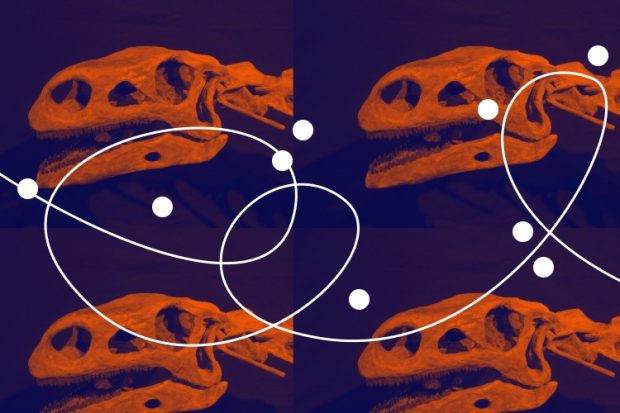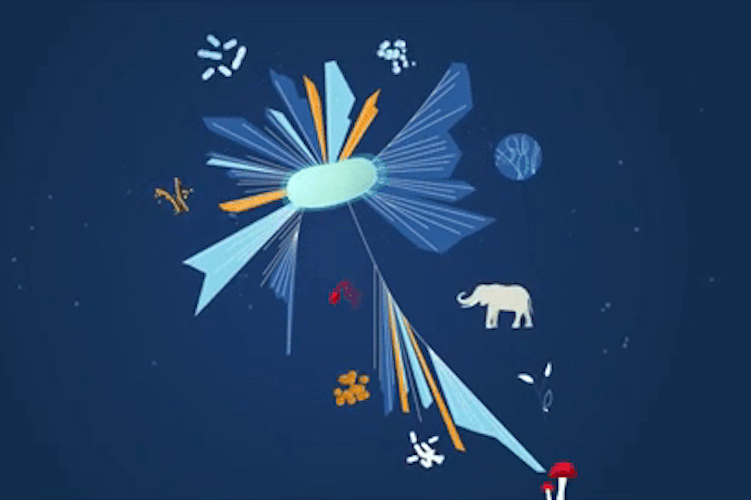Pterosaurs
Paleobiologist David Martill on pterodactyls, computer X-ray tomography, and the evolution of flight
faq | August 23, 2016
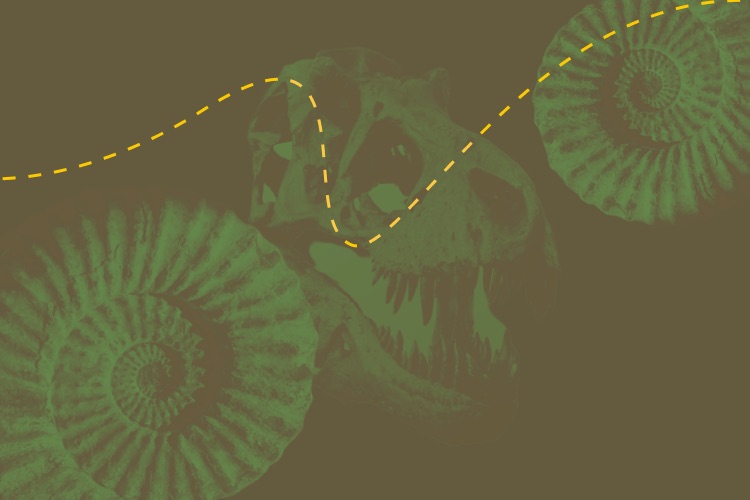
Pterosaurs are flying prehistoric reptiles. They lived from the end of the Triassic to the end of the Cretaceous and were spread around the globe. They died out at the same time as the large dinosaurs became extinct 65 million years ago. Pterosaurs are not dinosaurs as such but are very closely related to them, and many scientists place dinosaurs and pterosaurs in the same group called Ornithodira. Sadly, pterosaurs did not leave any descendants. The most closely related animals of today are crocodiles, which look nothing like pterosaurs, and birds, which, although they can fly, have a completely different wing structure, and evolved to have the ability to fly independently of pterosaurs.
Typically, a pterosaur had a pair of wings in which the fourth finger was highly elongated and made up of four finger bones. The wing was probably leathery like a bat’s and connected to the hind limb. In all but one or two pterosaurs, the head was larger than the body, sometimes considerably larger. Many pterosaurs possessed large teeth, but there were also toothless forms. Many also had head crests, and some were clad with fur.
History of Research
The first scientific account of a pterosaur fossil was published in 1784 by Alessandro Collini, who was in charge of a large fossil collection in Manheim, now Germany. Of course, Collini did not know what the fossil remains represented, and it was not until 1801 that the French comparative anatomist Georges Cuvier determined that Collini’s fossil remains were of a new type of fossil reptile, one that could fly. In 1809 Cuvier named the animal Pterodactylus.
There is, however, an earlier still record of a specimen of a pterodactyl. This was a small specimen in the collections of the Archduchess Maria Anna Jozefat of Buda (now Budapest, Hungary). However, this example was originally thought to be a fossil shrimp and was not recognized as a pterodactyl until 1856. Finally, there are some sketchy records of fossil bones found in England by quarrymen working roofing stone in the village of Stonesfield, near the University City of Oxford. These bones were identified as the remains of birds but were most likely from pterodactyls. The original specimens seem to have been lost. They were reported in The Gentleman’s Magazine in 1757.
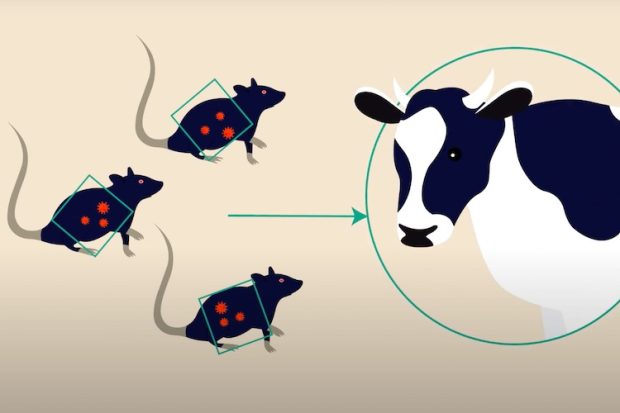
The confusion came in the 21st century when a group of intermediate pterosaurs was discovered. These pterosaurs, mainly from China but also known in England, had the short palm of the hand and long tail typical of the rhamphorhynchoids, but they had the skull of a pterodactyloid (combined nostril and antorbital fenestra). This group of pterosaurs, now known as Wukonopterids, after Wukonopterus from the Cretaceous of China, is still being studied in great detail. They tell us a lot about how pterodactyloid evolved from rhamphorhynchoids.
Research Methods
Pterosaur research is usually conducted on fossil specimens held in museum collections around the world. Some of the best collections are in Europe, especially the Natural History Museum in London, the Bavarian State Collection for Palaeontology and Geology in Munich, and the Karlsruhe Museum for Natural History, both of which are in Germany. There are also many hundreds of specimens in Chinese museums. This specimen-based research often involves detailed photography and measurements of bones.
Some researchers undertake fieldwork in an attempt to discover new pterosaur specimens. This is a risky endeavor because pterosaur bones are very rare, and there is a real chance that an expedition might return empty-handed with respect to pterosaurs. Their remains are much rarer than dinosaur remains, for instance. Nevertheless, there are a few places in the world where you can find lots of pterosaurs, but complete skeletons are still very rare indeed. For instance, Roland Poschl has found more than fifty nearly complete pterosaurs in his lifetime, but he has his very own quarry just for fossil collecting.
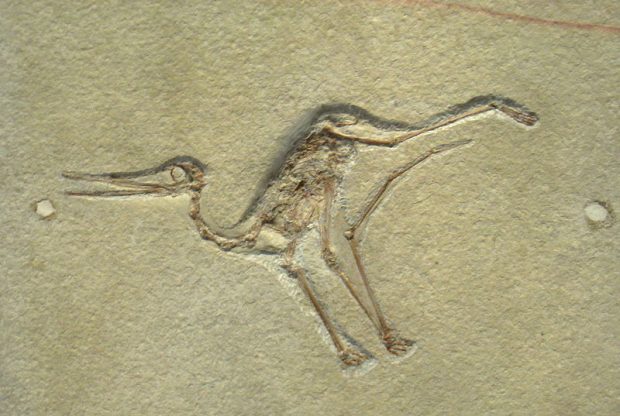
Fossil pterodactyloid flapling from the Solnhofen Limestone
Distinguishing pterosaur bones from dinosaur bones is usually very easy. Dinosaur bones are often hollow but never as hollow as pterosaur bones. Pterosaur wing bones are very long and slender and easy to recognize, and most pterosaur bones are exceedingly thin-walled. Because pterosaurs are adapted for flight, their skeleton is highly modified, and this makes their bones highly distinctive. The skill of paleontologists comes in identifying fragments of bones, which takes years of practice. It is the fragmentary nature of pterosaur fossils that often frustrates their study.
Evolution and Flight
The oldest pterosaurs are from the base of the Upper Triassic of the alpine regions of northern Italy, western Austria, and Switzerland. They are approximately 230 million years old. The youngest is from the very end of the Cretaceous and includes gigantic forms such as Quetzalcoatlus from Texas, Hatzegopteryx from Romania, and Arambourgiania from Jordan. These forms died out after the huge meteorite impact that wiped out the large dinosaurs 66 million years ago. So they were on Earth for 164 million years. In fact, it may have been slightly longer since we have not found the ancestral pterosaur yet.
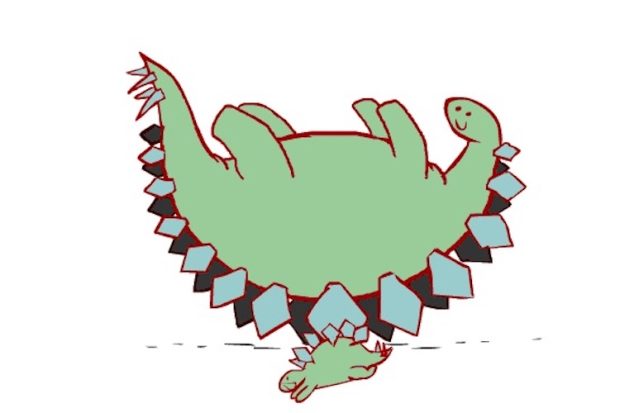
A few remarkable specimens from the Cretaceous of Brazil, China, and the Late Jurassic of Germany have allowed us to see the internal structure of the flight membranes, which include stiffening fibers, blood vessels, thin sheets of muscle, and a spongy layer that might have been hydrostatic to give the wing additional stiffness. Although some pterodactyl bodies show feather-like structures, no such structures have been found on the wing membranes.
Sadly, since no intermediate fossil has been found between a flying pterodactyl and their non-flying ancestors, it is unclear how this wing configuration came about. However, it involves the suppression of the fifth finger, hyper-elongation of the fourth finger, and, in the case of later forms, hyper-elongation of the metacarpals. A new bone appeared adjacent to the wrist, named the pteroid, which could control the propatagium. This was probably important for landing. A large deltopectoral crest on the humerus suggests they were powerful flappers, but larger forms would certainly have spent considerable time gliding. It is thought that a four-legged leap was required to get airborne, but the mechanism of take-off is not well understood.
Lifestyle
Pterosaurs inhabited a very wide range of environments, and this is borne out by their diversity of form, often most strongly manifested in the form of their neck, head, and teeth. Some were toothless and probably picked up food while strolling through vegetation, much like a stork does today. Others had long caniniform teeth that were ideal for catching fish. Some were insectivores, while others were filter feeds and probably waded through shallow waters straining small shrimps from the water. Webs on the feet of some pterosaurs show they could float on water like ducks. Actually, pterosaur remains have been encountered in lake and river deposits, in shallow marine deposits, and also in strata formed many hundreds of kilometers from land, which suggests some species may have been ocean-going like today’s albatrosses.
Another feature discovered in pterosaur fossils is elaborate head crests, some with color banding, which suggest the possibility of elaborate courtship displays or warning displays, or both. If their mating rituals were anything as diverse as the behavior seen in today’s birds, then we clearly still have a lot to learn about pterosaurs.
We do know, however, that pterosaurs almost certainly interacted with dinosaurs, but most likely as their food. There are at least two occurrences of pterosaurs with theropod dinosaur teeth embedded in their bones. In one example, a spinosaur tooth, probably from the South American spinosaur called Irritator, was found embedded in the neck of a pterosaur. In a second example, the tooth of a dromaeosaur (perhaps a Velociraptor) was found embedded in a wing bone. There is no evidence of any intimate relationships with dinosaurs, such as can be found between birds and large mammals.
More than Just Pterodactyls
There were many different types of pterosaurs. The smallest had short necks and wingspans of less than 1 meter. The largest had long necks (over two meters long) with large heads (also 2 meters plus) and a wingspan between 9 m and 13 m (in the case of Hatzegopteryx from Romania), which is incredible. Most early pterosaurs (Triassic to Late Jurassic) had long tails, some with a ‘flag’ on end, while all Cretaceous pterosaurs had proportionally short tails. The diversity of form in head crests is considerable. There are at least 120 different genera of pterosaur and many more species. And there are likely a lot more waiting to be discovered.
When they do, it is applied to a group of pterosaurs characterized by fusing the nostrils with a hole in the skull situated in front of the eye. This hole, known as the antorbital fenestra, joins with the nostril to form a big hole in the skull in front of the eye. Pterosaurs with this skull configuration are called Pterodactyloidea by scientists, and so the vernacular pterodactyloid, or pterodactyl, is used for this group. Typically they had short tails and grew very large in the Cretaceous.
Recent Discoveries
There have been many new discoveries of pterosaurs. Some of these are merely the discoveries of new species, and this has happened for Triassic, Jurassic, and Cretaceous forms. Quite likely, the number of genera described in the last 20 years is double that of all those discovered in the 200 years before. More importantly, there have been many new discoveries that have allowed us to interpret the palaeobiology and ecology of pterosaurs. Pterosaur eggs with embryos inside have been reported from Argentina and China, while one pterosaur egg, still inside the female, has been reported from China, which shows that they possessed double ovaries.
The pterosaur embryos have fully developed skeletons with skeletal proportions similar to those of adults, which suggests that baby pterosaurs may have been able to fly very soon after hatching from the egg. In China and Brazil, pterosaur nesting sites have been found, which suggests some sort of group nesting activity. Analysis of the rib cage of Pteranodon has shown a complex respiratory pumping system using an array of highly modified ventral and lateral ribs, perhaps linked with the front of the pelvis.
There have been a number of studies to estimate the body mass of pterosaurs, and these have shown that some were rather heavier than previously thought. Notably, the larger pterosaurs, such as Quetzalcoatlus, were heavily built, and this might suggest that they were reluctant flyers, spending much of their time on the ground. Analysis of the brain casts of pterosaurs has shown that they had enlarged (when compared to those of birds) semicircular canals, and the orientation of such suggests that they flew with their heads in a downward position, unlike birds that fly with beaks directed forwards.
There remain many unanswered questions about pterosaurs, but there seems to be a good supply of new specimens almost every year. There are also new techniques to study pterosaurs, the most exciting of which is the CT scanner. Computer X-ray tomography allows paleontologists to see the internal details of bones at very high magnifications and often with high fidelity. The most powerful machines allow specimens to be examined while still in the rocks. The technique can be very expensive, especially for high-tech machines such as synchrotrons, but the results are often outstanding. This and other techniques have permitted reanalysis of specimens collected many decades ago and so the future is very bright for pterosaur researchers.
Edited by Alina Shubina











